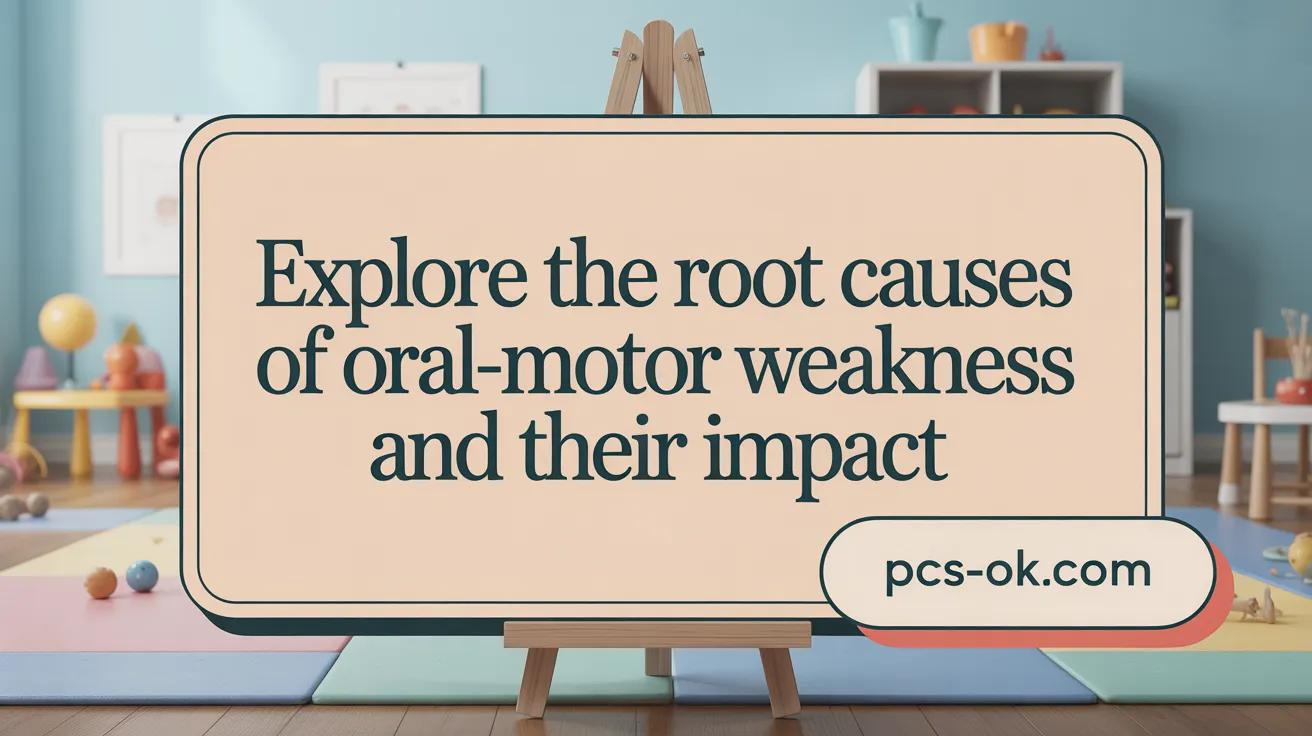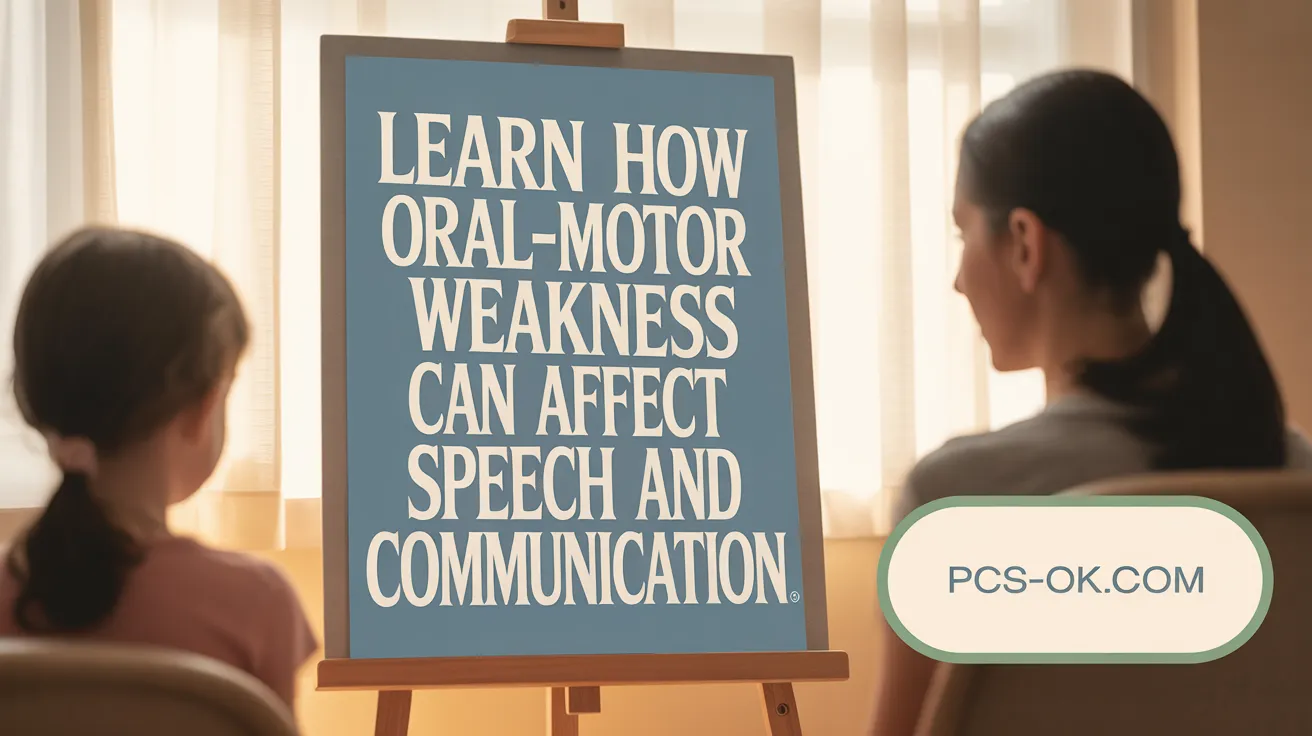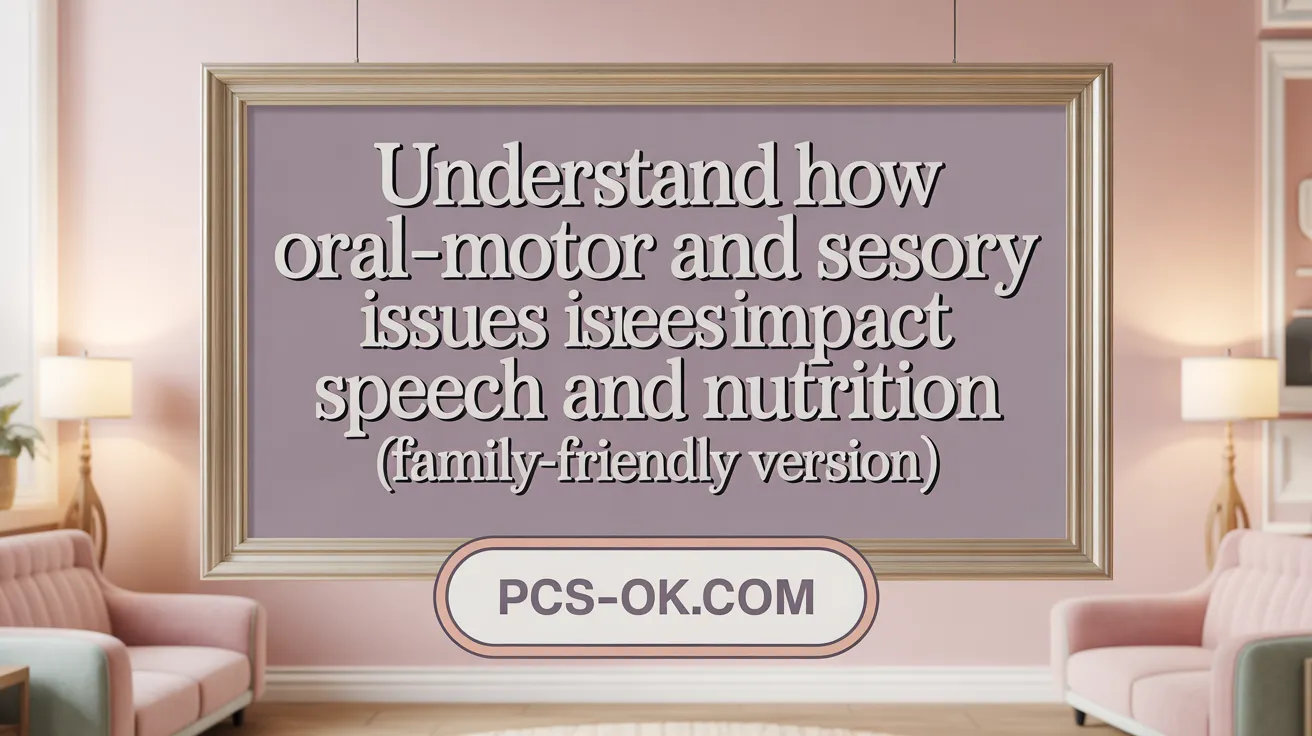Signs of Oral-Motor Weakness That Affect Speech
Recognizing the Importance of Oral-Motor Function
Oral-motor weakness, affecting the muscles of the mouth and face, plays a crucial role in speech clarity, eating, and overall communication. Identifying the signs early can lead to timely intervention and improved outcomes. This article explores the signs and symptoms, causes, diagnostic methods, and the relationship between oral-motor weakness and speech disorders, providing a comprehensive overview for caregivers, educators, and healthcare professionals.
Key Signs and Symptoms of Oral-Motor Weakness Affecting Speech

What are the common signs and symptoms of oral-motor weakness affecting speech?
Oral-motor weakness can significantly impact speech clarity and overall oral function. Common indicators include slurred, slow, or difficult-to-understand speech, often accompanied by difficulty controlling the muscles of the lips, tongue, and jaw. Individuals might exhibit excessive mouth movements or hold their mouths open during speech, which suggests impaired muscle coordination.
In addition to speech issues, feeding and swallowing difficulties are frequently observed. People may gag, choke, or cough while eating or drinking, and experience drooling, especially past age two. These symptoms reflect a challenge in the muscle strength and coordination necessary for safe swallowing.
Observable behaviors during speech can include prolonged pauses between words, distortion of sounds, and inconsistent pronunciation of words. Some affected individuals may have a nasal voice or produce sounds with a harsh or monotone quality. Difficulty producing complex words, omitting syllables, or switching sounds can also be signs.
Early identification of these signs is critical. Speech therapy and other interventions can help strengthen oral muscles, improve coordination, and enhance communication skills. Addressing these signs promptly can prevent further developmental delays in speech, swallowing, and social interaction.
Early Indicators of Oral-Motor Dysfunction in Children and Adults

What are the early indicators of oral-motor dysfunction in children and adults?
Oral-motor dysfunction can be identified early through signs exhibited during eating, speaking, or facial movements. In children, common indicators include difficulty sucking from bottles or straws, a strong preference for soft foods, refusal to eat harder or chewy foods like fruits, vegetables, or meats, and behaviors such as holding the mouth or lips open.
Additionally, children may show signs like slow or inefficient chewing, excessive drooling past age 2, and swallowing problems. Speech-related symptoms include difficulty saying long or complex words, slurred or slow speech, and adding or omitting syllables. These signs reflect underlying issues with muscle control and coordination.
In adults, early concerns often involve challenges with speech clarity, such as slurred or mumbling speech, and problems controlling facial muscles during speech. During meals, adults may experience fatigue, mouth holding, or difficulty controlling lip, tongue, or jaw movements, which may lead to coughing, choking, or gagging.
Mouth holding, slow or effortful eating, and speech sound errors are common across age groups. Recognizing these early warning signs helps healthcare providers to promptly evaluate and address potential underlying causes, including muscle weakness, neurological conditions, or structural anomalies.
Why is early detection important?
Early identification allows for timely intervention, which can significantly improve functional outcomes. Addressing oral motor challenges early helps prevent secondary issues such as nutritional deficiencies, social withdrawal during meals, or speech delays. Intervention strategies often include therapy with speech-language pathologists and occupational therapists, focused on strengthening muscles, improving coordination, and developing adaptive techniques. Recognizing these signs early can reduce the risk of future complications and support better social and developmental progress for individuals affected by oral-motor difficulties.
Underlying Causes and Risk Factors of Oral-Motor Weakness

Oral-motor weakness, which affects the muscles involved in speech, eating, and swallowing, can stem from various causes. Understanding these underlying factors is essential for early diagnosis and effective intervention.
One major category includes neurological and developmental causes. Conditions such as cerebral palsy, stroke, traumatic brain injuries, and neurodegenerative diseases like multiple sclerosis or Parkinson’s disease are common contributors. These neurological issues impair muscle coordination and strength, leading to difficulties in sucking, chewing, and speech. Additionally, genetic syndromes like Down syndrome and developmental delays influence the maturation of oral-motor skills.
Structural abnormalities in the mouth or face also significantly impact oral function. For example, cleft palate, lips, or tongue ties restrict movement and coordination of oral muscles. Craniofacial syndromes may cause misalignment or jaw issues that hinder normal muscle activity. Trauma or surgical interventions involving the face or mouth can further compromise muscle strength and coordination.
Environmental and behavioral factors play a notable role as well. Premature birth is a risk factor because it may interrupt critical periods of muscle development and feeding skill acquisition. Prolonged use of feeding bottles, pacifiers, or oral appliances can inhibit natural muscle growth, resulting in weak or uncoordinated oral muscles. Sensory or behavioral disorders, like autism spectrum disorder, often associate with food aversions, mouth hypersensitivity, or poor muscle tone, which can complicate feeding and speech development.
Overall, any disease, injury, or developmental disruption that affects the nervous system, oral tissues, or facial structures can lead to oral-motor weakness. Early recognition of these causes allows for tailored interventions that improve motor skills, nutrition, and communication abilities.
| Cause Category | Examples | Impact on Oral Function |
|---|---|---|
| Neurological Conditions | Cerebral palsy, stroke, traumatic brain injury, MS | Impair muscle coordination, strength, and timing |
| Structural Abnormalities | Cleft palate, tongue tie, craniofacial syndromes | Restrict movement, affect muscles involved in feeding and speech |
| Developmental Factors | Premature birth, genetic syndromes (e.g., Down syndrome), delays | Delay muscle development, weaken oral-motor skills |
| Environmental & Behavioral | Prolonged use of bottles, pacifiers, oral appliances, sensory disorders | Inhibit muscle growth, cause sensory hypersensitivity or hyposensitivity |
Diagnostic Assessments and Identifying Signs of Oral-Motor Issues

What assessments and diagnostic signs are used to identify oral-motor issues?
Identifying oral-motor problems requires a combination of clinical examinations, standardized tests, and instrumental evaluations. Clinicians often start with a thorough oral-motor examination to assess the strength, coordination, and range of motion of the lips, tongue, and jaw. This involves observing how the child or adult moves their face and mouth during non-speech actions like smiling, puckering, or protruding the tongue.
Standardized speech and feeding assessments conducted by speech-language pathologists (SLPs) are essential for evaluating the development of speech sounds, feeding behavior, and specific oral-motor skills. These evaluations often include observing the patient’s ability to suck, chew, swallow, and articulate sounds clearly.
Instrumental assessments provide detailed insights into swallowing and orofacial function. The videofluoroscopic swallow study, also known as a Modified Barium Swallow, is a common imaging technique used to observe the process of swallowing in real-time, helping identify risks such as aspiration or incomplete swallowing.
During examination, additional signs like difficulty swallowing or gagging, slow eating, drooling, or speech errors such as slurred speech or inconsistent articulation may signal underlying issues. Structural abnormalities, such as tongue tie or misaligned jaw, can be detected through visual and palpation examinations.
A multidisciplinary approach enhances diagnostic accuracy. Collaboration among speech therapists, neurologists, ENT specialists, and developmental pediatricians allows for comprehensive assessments. These professionals analyze signs like open-mouth posture, oral sensory sensitivities, abnormal habits such as tongue thrusting, and muscle weakness to pinpoint specific oral-motor disorders and plan suitable interventions.
| Assessment Type | Focus Area | Additional Details |
|---|---|---|
| Clinical oral-motor examination | Strength, coordination, ROM of facial structures | Non-speech actions, structural evaluation |
| Standardized speech/feeding evaluations | Speech sound development, feeding skills | Performed by trained speech-language pathologists |
| Instrumental assessments (swallow study) | Swallowing function, risk of aspiration | Videofluoroscopic imaging |
| Visual and structural examination | Structural abnormalities, oral habits | Observation of oral posture and musculature |
| Diadochokinetic tasks | Articulatory coordination | Rapid repetitions of speech sounds |
Discussing these assessments and signs enables early diagnosis, which is crucial for effective intervention. Recognizing symptoms such as gagging, slow feeding, speech difficulty, or abnormal oral habits prompts timely professional evaluation, guiding targeted therapy to improve oral-motor function and overall development.
Relationship Between Oral-Motor Weakness and Speech Disorders: Dysarthria and Apraxia

How is oral-motor weakness related to speech disorders such as dysarthria and apraxia?
Oral-motor weakness plays a significant role in some speech disorders, particularly dysarthria. In dysarthria, the muscles involved in speech—such as the tongue, lips, jaw, and vocal folds—are weakened or lack coordination. This results in speech that may sound slurred, slow, or overly harsh, making it difficult for others to understand. The underlying issue is muscular in nature, often caused by neurological damage affecting muscle strength and control.
Conversely, apraxia of speech primarily involves deficits in the brain’s ability to plan and program the movements necessary for speech. In children with speech apraxia, muscle strength is usually intact, but they struggle with initiating and sequencing the correct movements of articulator muscles, such as the lips and tongue. As a result, their speech may be inconsistent, with difficulties in producing accurate sounds or the correct order of sounds within words.
While both conditions impair speech clarity, their origins are distinct. Dysarthria is rooted in muscular weakness or incoordination, whereas apraxia results from higher-level motor planning deficits. Accurate diagnosis by speech-language pathologists is essential because treatment strategies differ. For example, muscular strengthening exercises are more effective for dysarthria, while motor planning therapies are suited for apraxia.
Understanding this relationship allows clinicians to develop tailored intervention plans, improving the effectiveness of therapy and enhancing communication outcomes for affected individuals.
| Aspect | Dysarthria | Apraxia | Role of Oral-Motor Weakness | Diagnosis and Treatment Focus |
|---|---|---|---|---|
| Cause | Muscle weakness or incoordination | Motor programming impairment | Significant in dysarthria | Strengthening muscles, enhancing control |
| Speech Characteristics | Slurred, slow, labored speech | Inconsistent errors, groping movements | Underlying deficit | Motor exercises, speech-motor planning |
| Key Differentiator | Muscle control affected | Motor planning affected | Central to diagnosis | Tailored therapy approaches |
| Treatment Strategies | Speech therapy focusing on muscle strength | Motor planning therapy | Essential for effective intervention | Accurate diagnosis to choose appropriate therapy |
This understanding underscores the importance of precise assessment to differentiate between these neurological speech disorders. Proper diagnosis ensures targeted therapy, whether aimed at strengthening muscles or improving motor planning skills, ultimately leading to better communication abilities.
Oral-Motor and Oral-Sensory Problems Affecting Speech and Eating

What oral-motor and oral-sensory problems impact speech and eating?
Oral-motor and oral-sensory issues play a crucial role in a child’s ability to eat, speak, and perform facial movements effectively. Oral-motor problems involve difficulties with the muscles controlling the lips, tongue, jaw, and palate. These difficulties can manifest as weak muscle strength, reduced coordination, limited range of motion, or delayed muscle development, impacting tasks like chewing, swallowing, and articulate speech. Children might gag or choke during meals, have trouble sucking from bottles or straws, or refuse hard textures, which can hinder proper nutrition and growth.
Simultaneously, oral-sensory problems pertain to how the mouth perceives and reacts to taste, temperature, and textures. Children with hypersensitivity may gag, grimace, or refuse to eat certain foods, while hyposensitive children might not feel food in their mouths, leading to food dropping and reduced oral intake. These sensory challenges can cause feeding aversions, delayed developmental milestones for eating, and nutritional deficits.
Both sets of issues often coexist, resulting in complications such as aspiration risks, dehydration, and long-term speech delays. Early diagnosis through comprehensive evaluations by speech-language pathologists, occupational therapists, and medical professionals helps identify specific motor or sensory concerns. Addressing these problems typically involves customized therapy approaches focused on improving muscle strength and control, desensitization strategies for sensory sensitivities, and adaptable feeding techniques to ensure safety and adequate nutrition.
Effects on feeding behavior, nutrition, and safety
Children with oral-motor and oral-sensory disorders frequently exhibit irregular feeding behaviors. These can include slow feeding, food refusal, excessive drooling, and prolonged mealtimes, which may lead to inadequate caloric intake and growth delays. The risk of choking, gagging, or aspiration increases, especially with textures that challenge the child’s oral control.
In addition to immediate safety concerns, these issues can cause emotional stress for the child and family, leading to behavioral problems and social withdrawal during mealtime. Persistent difficulties may also result in poor weight gain, nutritional deficiencies, and impacts on brain development due to inadequate nutrient intake.
Therapeutic approaches for motor and sensory challenges
Management of oral-motor and oral-sensory problems requires a multidisciplinary effort. Speech-language pathologists often focus on strengthening and coordinating oral muscles through specific exercises and practicing proper speech and swallowing techniques.
Occupational therapists may employ desensitization and sensory integration therapies to help children tolerate different textures and tastes, reducing gag reflexes and food aversions.
Behavioral therapy can reinforce positive feeding behaviors and help establish regular eating routines. In some cases, modifications like altering food textures, using adaptive feeding equipment, or implementing specific feeding techniques are recommended to make eating safer and more comfortable.
Early intervention is vital, as it can significantly improve outcomes, promoting better nutritional health, safer eating practices, and clearer speech development.
| Aspect | Concerns | Related Strategies |
|---|---|---|
| Muscle function | Weakness, poor coordination, limited range | Exercises, biofeedback, strengthening activities |
| Sensory perception | Over-sensitivity or under-sensitivity to textures, tastes | Desensitization, sensory integration therapy |
| Feeding safety | Choking, aspiration, food refusal | Modified textures, adaptive equipment, supervised feeding |
| Speech development | Delay or articulation difficulties | Speech therapy, targeted exercises |
| Overall impact | Nutrition deficits, developmental delays | Multidisciplinary assessment, early intervention |
Addressing these intertwined issues is crucial for supporting a child’s developmental trajectory, ensuring safe eating habits, and fostering effective communication skills.
Strategies for Intervention and Therapy to Improve Oral-Motor Function

Role of speech and occupational therapy
Speech therapists and occupational therapists play crucial roles in managing oral-motor dysfunction. Speech therapists focus on exercises that strengthen the lips, tongue, and jaw, helping improve speech clarity and eating skills. They may use techniques like oral motor exercises, speech drills, and nonverbal communication strategies. Occupational therapists work on developing muscle strength, coordination, and sensory processing. They help children improve self-feeding skills and adapt to sensory sensitivities by using desensitization techniques and behavioral interventions.
Importance of early intervention
Starting therapy early is vital for better developmental outcomes. Early intervention can help prevent long-term speech delays, feeding problems, and social difficulties. Recognizing signs such as difficulty sucking, swallowing, or speaking at a young age allows for prompt assessment and treatment. When addressed early, children are more likely to develop normal eating and speaking skills, reducing future health and behavioral issues.
Multidisciplinary approaches for comprehensive care
A collaborative approach ensures all aspects of oral motor development are addressed. This involves pediatricians, speech-language pathologists, occupational therapists, ENT specialists, and sometimes dental professionals. Together, they evaluate the child’s needs, conduct assessments like swallow studies, and create personalized therapy plans. This team-based strategy optimizes treatment effectiveness, helping children improve muscle strength, coordination, sensory responses, and speech clarity.
| Aspect | Role | Focus | Typical Interventions |
|---|---|---|---|
| Speech Therapy | Improve speech and swallowing | Articulation, muscle strength | Oral motor exercises, speech drills |
| Occupational Therapy | Enhance muscle coordination and sensory integration | Self-feeding, sensory desensitization | Muscle strengthening, sensory activities |
| Medical Management | Diagnose and monitor underlying causes | Structural issues, neurological conditions | Imaging, medical treatments |
| Dental and Surgical Support | Address oral restrictions or anatomical anomalies | Tongue tie, jaw misalignments | Surgery, orthodontics |
Implementing these strategies through a collaborative, early approach can significantly improve the oral-motor capabilities of children facing these challenges.
Enhancing Communication Through Early Identification and Intervention
Oral-motor weakness has wide-ranging effects on speech clarity, feeding, and overall communication. Recognizing its signs early, understanding the underlying causes, and employing thorough assessments ensure appropriate diagnosis and treatment. Targeted therapies involving speech and occupational specialists not only improve muscle strength and coordination but also address sensory challenges, enabling individuals to develop clearer speech and safer, more efficient eating habits. Early and multidisciplinary intervention remains key to preventing long-term complications and enhancing quality of life for those affected by oral-motor weakness.
References
- What You Should Know About Oral Motor Dysfunction
- Oral Dysfunction 101: What you need to know
- Dysarthria (Slurred Speech): Symptoms, Causes & Treatment
- What is Oral Motor Weakness?
- Oral Motor Dysfunction in Children: How Occupational and …
- What Is Oral Motor Therapy and Does My Child Need It?
- Childhood apraxia of speech – Symptoms and causes
- What is an oral motor disorder?
- Possible Oral Apraxia or Oral Motor Warning Signs
- About oral motor and oral sensory problems
